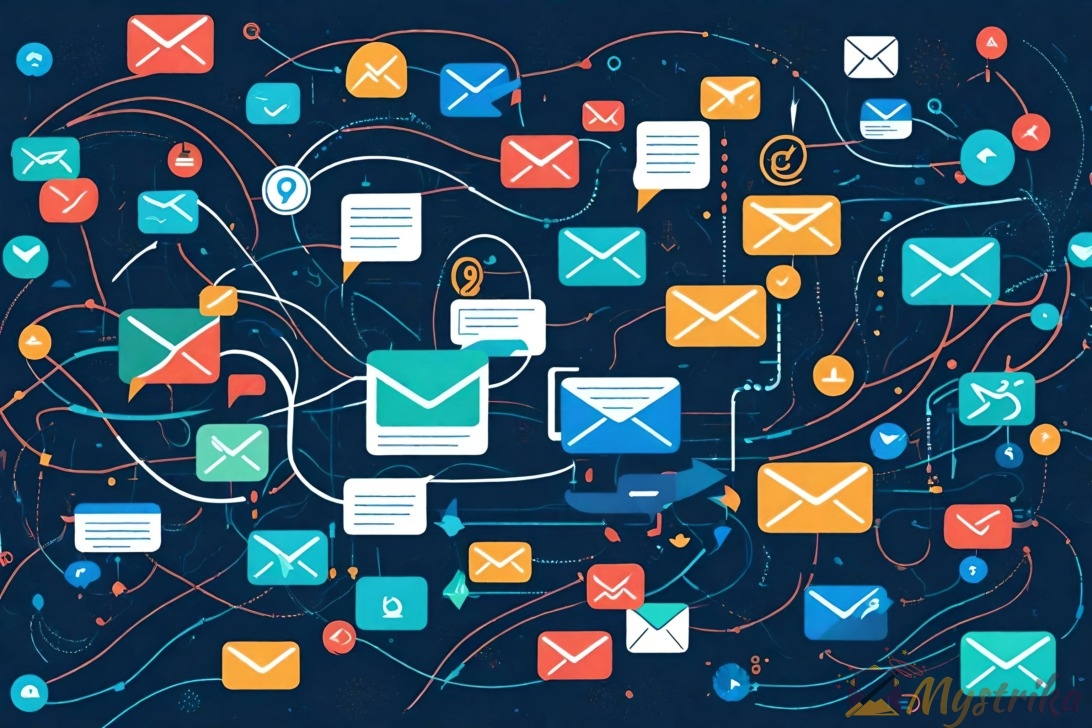Are you tired of sending out cold emails with no response? It’s like shouting into the void, hoping someone will hear you. But what if I told you there was a way to improve your email deliverability and increase your chances of getting a response? Enter email feedback loops.
Email feedback loops are like a secret weapon in the world of email marketing. They allow you to maintain sender reputation and avoid being marked as spam, which can be detrimental to your outreach efforts. In this article, we’ll dive deep into understanding email feedback loops in cold email outreach and how they can benefit your strategy. So get ready to take control of your inbox and unlock the power of effective email outreach techniques!
The Importance of Maintaining Sender Reputation in Email Marketing
You need to prioritize maintaining your sender reputation in email marketing if you want your messages to reach the right people and avoid being flagged as spam. Maintaining reputation means ensuring that your emails are delivered to the recipient’s inbox and not filtered out by email filters, which can lead to lower open rates, click-through rates, and ultimately harm the success of your outreach campaign.
Email filters are sophisticated algorithms programmed into email clients’ servers that scan incoming emails for specific factors such as subject line keywords, IP address history, sender’s domain reputation, and content quality. If an email triggers any of these filters, it may be marked as spam or sent straight to the junk folder. Once flagged as spam by a single user or ISP (Internet Service Provider), future emails from the same sender will automatically go into recipients’ Spam folders.
Maintaining Reputation is crucial because once you get labeled a spammer; it’s hard to reverse that perception. The best way is to maintain high-quality lists with active subscribers who engage with your emails regularly. You also need good content that provides value to your readers so they’ll keep opening and clicking on links within those messages. By doing this consistently over time, you’ll build trust with ISPs and increase your chances of reaching more potential customers through their inboxes rather than having them filtered out by email clients’ servers.
By understanding how maintaining reputation affects email deliverability and using effective strategies for improving it, you can ensure your cold outreach campaigns are successful. However, there’s more than just maintaining reputation when it comes to sending cold emails effectively; next up is understanding Email Feedback Loops.
Understanding Email Feedback Loops
You might be thinking, “I don’t want to get stuck in a never-ending cycle of bounced emails and angry replies.” The solution lies in understanding email feedback loops. Feedback loops are essential for maintaining good sender reputation and improving email deliverability strategies. They allow mailbox providers to provide feedback to senders about email complaints, bounces, and spam reports.
Inbox placement optimization is crucial in cold email outreach because it determines whether your emails land in the recipient’s inbox or spam folder. Feedback loops help you monitor your reputation by alerting you when people mark your emails as spam. This information helps you improve future campaigns by allowing you to identify the root cause of the problem and fix it before it affects your ability to reach prospects.
Understanding how email feedback loops work is vital for anyone who wants to optimize their inbox placement rates. It provides valuable insights into how recipients perceive their messages and allows them to make changes proactively rather than reacting after problems occur. By monitoring feedback loops regularly, you can keep up with any changes that may affect your sender reputation, ensuring that your emails continue reaching their intended targets without getting lost or marked as spam.
How Email Feedback Loops Work
Get ready to have your mind blown as we dive into the intricate workings of email feedback loops and how they can make or break your email deliverability game. Email feedback loops are essential for any cold email outreach campaign, but understanding their benefits and challenges is crucial before setting them up.
Email feedback loop benefits include ensuring that your emails reach their intended recipients by monitoring spam complaints and allowing you to take corrective action. By analyzing these reports, you can identify potential issues with your messaging or targeting strategy and adjust accordingly. Additionally, email feedback loops provide a way for you to build trust with internet service providers (ISPs) by demonstrating that you are committed to maintaining high delivery rates.
While there are many advantages to using an email feedback loop, there are also some challenges that must be considered. One such challenge is the possibility of false positives – when someone marks your message as spam without actually requesting it. This can negatively impact your reputation with ISPs and ultimately harm your deliverability rates. However, by regularly monitoring and adjusting based on feedback loop reports, you can minimize these risks while still reaping the benefits of this powerful tool.
With a solid understanding of how email feedback loops work and their associated benefits and challenges, it’s time to set one up for yourself. In the next section, we’ll explore the steps involved in creating an effective email feedback loop that will help ensure maximum inbox placement for all of your future cold outreach campaigns.

Setting Up Email Feedback Loops
In the section ahead, we’ll cover how to set up a powerful tool that can boost your email deliverability game: email feedback loops. As mentioned in the previous subtopic, feedback loops are essential in maintaining a high sender reputation and preventing your emails from being marked as spam. By setting up an email feedback loop, you gain access to valuable information about your subscribers’ engagement levels and feedback on your content.
One of the benefits of implementing an email feedback loop is that it improves email deliverability by reducing bounce rates and complaints. However, there are challenges in setting up this tool, such as working with multiple ISPs and complying with their varying policies. It also requires technical expertise and resources to ensure that everything runs smoothly.
Despite these challenges, it’s worth investing time and effort in implementing an email feedback loop because it provides insights into subscriber behavior that can help you optimize future campaigns. With this tool in place, you can identify inactive subscribers or those who mark your emails as spam so that you can remove them from your list or adjust your content strategy accordingly.
By setting up an email feedback loop, you’re taking a significant step towards improving your overall email deliverability rate. In the next section, we’ll delve deeper into how this tool can improve your sender reputation and increase engagement from subscribers who appreciate receiving personalized content tailored specifically to their needs.
How Feedback Loops Can Improve Your Email Deliverability
Discovering how feedback loops can enhance your email deliverability is a powerful way to evoke an emotional response and inspire action. Feedback loops allow you to understand the impact of your cold outreach on recipients. They provide insight into how your emails are being received and help you tailor future communications based on this information.
Using feedback loops for email personalization is one way to maximize engagement with potential clients. For example, if a recipient has marked an email as spam or unsubscribed from your list, it’s important to take note of the reason why. Perhaps you need to adjust the content or tone of your messages, or maybe there was simply a miscommunication that can be resolved with clearer language.
Overall, incorporating feedback loops into your cold email outreach strategy can have a significant impact on your email deliverability and success rates. By taking note of what works and what doesn’t, you can make targeted adjustments that will improve overall engagement with potential clients. Next up, we’ll explore the role of email list hygiene in cold email outreach and how it contributes to successful campaigns.
The Role of Email List Hygiene in Cold Email Outreach
Maintaining a clean and updated email list is crucial for successful engagement with potential clients in your outreach campaigns. Email list cleaning involves removing invalid or inactive email addresses, eliminating duplicates, and unsubscribing those who have opted out. This process helps to improve deliverability rates, reduce bounce rates, and avoid spam complaints.
Bounce management is another aspect of email list hygiene. Bounces occur when an email is undeliverable due to incorrect or non-existent addresses. High bounce rates can negatively impact your sender reputation and result in emails being marked as spam. By managing bounces and regularly updating your contact lists, you can improve the effectiveness of your cold email outreach efforts.
By prioritizing email list hygiene practices like cleaning and bounce management, you can increase the likelihood of reaching your target audience with relevant content that meets their needs. When you have a clean list of engaged subscribers who look forward to hearing from you, it becomes easier to build trust and credibility over time. In the next section about best practices for cold email campaigns, we’ll explore other techniques that can help further boost engagement rates with your target audience.
Best Practices for Cold Email Campaigns
Want to increase engagement rates with your target audience? Check out these best practices for crafting effective cold email campaigns. First and foremost, personalization techniques are essential. Generic emails that don’t address the recipient by name or reference their specific needs won’t get you far. Make sure to research your prospects beforehand and tailor each message accordingly.
Next up, pay attention to your subject lines. This is the first thing your recipients will see, so make it count! Your subject line should be short, engaging, and clearly convey what’s in it for them if they open the email. Avoid using click-bait tactics or over-promising on what you can deliver, as this will only lead to disappointment down the line.
Now that you have a solid understanding of how to craft effective cold emails, it’s time to put those skills into action. But before hitting send on a massive campaign, remember that testing and optimization are crucial components of any successful outreach strategy. In the next section, we’ll explore why this step is so important and provide tips on how to do it effectively. Stay tuned!

The Importance of Testing and Optimization in Cold Email Outreach
Now that you know the best practices for cold email campaigns, it’s time to talk about the importance of testing and optimization in your outreach efforts. As with any marketing strategy, A/B testing is crucial for figuring out what works and what doesn’t. This means sending out two different versions of your email to a small sample audience and analyzing which one performs better before sending it out to your entire list.
One important aspect of A/B testing is personalized email content. People are more likely to engage with emails that feel tailored specifically to them. By personalizing subject lines, greetings, and even the body of your email, you can increase open rates and ultimately conversions.
Don’t be afraid to experiment with different subject lines or calls-to-action either. And remember, successful A/B testing requires patience and consistency over time as you gather data on what resonates best with your audience. In the end, this process will help fine-tune your approach and lead to greater success in reaching new customers through cold email outreach.
As you continue to test and optimize your cold email campaign, it’s important not only to track click-through rates but also monitor conversion rates. The goal is not just getting people to open or click on an email but actually converting them into paying customers or clients. In the next section, we’ll explore how monitoring and analyzing these metrics can help you refine your approach even further towards achieving optimal results.
How to Monitor and Analyze Your Email Campaign Performance
To truly improve your email campaign performance and achieve better results, you need to keep a close eye on how your audience is responding to your messages and make adjustments accordingly. Email campaign tracking is crucial in understanding what works and what doesn’t in cold email outreach. Performance analysis helps you identify gaps in your strategy, which can be used as an opportunity for improvement.
Here are two sub-lists that can help you monitor and analyze the performance of your email campaigns:
- Metrics to track: Open rates, click-through rates (CTR), bounce rates, conversion rates, response rates
- Open rates show how many people opened your emails.
- CTR shows how many people clicked on a link within the email.
- Bounce rates indicate how many emails failed to reach their destination.
- Conversion rates show how many recipients took the desired action after opening or clicking through an email.
- Response rates demonstrate how many replies or positive feedback you received from recipients.
- Tools for analysis: Email marketing software, Google Analytics
- Email marketing software provides detailed reports about email campaigns’ performance metrics and allows you to compare them over time.
- Google Analytics helps track website traffic resulting from clicks on links within emails.
By monitoring these metrics regularly and analyzing them effectively using appropriate tools, you can make informed decisions about adjusting your approach to increase engagement with potential customers.
Keep in mind that some common mistakes may obstruct effective cold email outreach efforts. These include sending generic messages that lack personalization or relevance to the recipient’s needs. In the next section, we will discuss these mistakes further so that you can avoid them altogether.
Common Mistakes to Avoid in Cold Email Outreach
In the following section, we’ll explore common mistakes to steer clear of when reaching out to potential customers via email. One of the biggest mistakes you can make is not personalizing your emails. Generic messages that don’t speak directly to your recipient’s needs or interests will likely end up in the trash folder. Instead, take the time to research and segment your audience so that you can craft targeted messages that resonate with them.
Another common mistake is sending too many follow-up emails. While it’s important to be persistent, bombarding your prospects with multiple messages in a short period of time can come across as pushy and annoying. Instead, space out your follow-ups over a few days or even weeks, and make sure each one provides value or addresses a specific pain point for your prospect.
Lastly, avoid using spammy tactics like misleading subject lines or false urgency. These tactics may get more people to open your email initially, but they’ll quickly lose trust in you if they feel misled or manipulated. Be honest and transparent about what you’re offering, and focus on building genuine relationships with your prospects based on their needs and interests.
As you work on perfecting your cold email outreach strategy, keep these common mistakes in mind and strive to avoid them at all costs. By focusing on personalization techniques and targeted messaging while avoiding spammy tactics like misleading subject lines or excessive follow-up emails, you’ll be well on your way to building long-term relationships with potential customers who are genuinely interested in what you have to offer. In the next section, we’ll discuss how to handle unsubscribes and opt-outs in your email marketing campaigns without damaging those relationships – let’s dive in!
How to Handle Unsubscribes and Opt-Outs in Your Email Marketing Campaigns
You may feel discouraged when someone unsubscribes from your email marketing campaigns, but did you know that 69% of recipients unsubscribe because they receive too many emails? It’s important to understand that unsubscribes are a natural part of email marketing and opt-out management is crucial. By offering a clear unsubscribe option in every email and respecting the recipient’s decision to opt out, you can maintain a positive reputation and avoid being marked as spam.
Unsubscribe etiquette also includes removing unsubscribed addresses promptly from your mailing list. This helps prevent future emails from being sent to those who have opted out, which can damage your sender reputation and result in further complaints. Additionally, regularly reviewing your email frequency and segmenting your audience can help reduce the number of opt-outs.
Proper opt-out management not only shows respect for the recipient’s preferences but also ensures compliance with regulations such as CAN-SPAM laws. By implementing effective unsubscribe strategies, you can build trust with your audience and improve the overall success of your email marketing campaigns.
As you continue to refine your cold email outreach strategies, it’s important to consider the role of email compliance in maintaining a positive reputation and avoiding legal issues. By ensuring that all emails include an easy-to-use unsubscribe option and following other best practices for opt-out management, you can stay on top of industry standards while building strong relationships with potential customers.

The Role of Email Compliance in Cold Email Outreach
As a savvy cold email outreach marketer, you need to know the ins and outs of email compliance. Two key regulations you must be familiar with are the CAN-SPAM Act Compliance and GDPR Compliance. These rules cover important areas such as opt-ins, unsubscribe requests, data privacy, and transparency in your email campaigns. By following these regulations, you can build trust with your audience and avoid legal issues that may harm your reputation or business.
CAN-SPAM Act Compliance
Make sure your emails are compliant with the CAN-SPAM Act by including a clear subject line, your company’s physical address, and an easy opt-out option for recipients. The email marketing regulations set forth in the act require businesses to follow specific email compliance guidelines to avoid being fined or even blacklisted by internet service providers. By complying with these regulations, you show respect for your potential customers’ privacy and their right to choose whether or not they want to receive your messages.
To ensure that you are meeting CAN-SPAM Act compliance standards, always include a visible unsubscribe link in your emails. This gives recipients the freedom to opt-out of receiving further communications from you at any time, which is essential for building trust and keeping them engaged with your brand. When you make it easy for people to control their inbox experience, you increase the chances of building long-term relationships with interested parties. Now let’s discuss GDPR compliance and how it impacts cold email outreach practices.
GDPR Compliance
Navigating GDPR compliance is like maneuvering through a maze of regulations and requirements when it comes to sending marketing emails. To ensure that you are following the GDPR guidelines, here are some key points to keep in mind:
- Obtain explicit consent from your email recipients before adding them to your mailing list.
- Clearly communicate the purpose of collecting their data and how it will be used.
- Provide an easy opt-out option for recipients who wish to unsubscribe from your emails.
Data protection is at the heart of GDPR compliance. It’s important that you take all necessary measures to protect the data you collect from your subscribers. This includes regularly reviewing and updating your privacy policy, using secure servers to store subscriber information, and limiting access to only those who need it. By staying compliant with GDPR guidelines, you not only avoid hefty fines but also build trust with your subscribers by showing that you value their privacy.
As you navigate through GDPR compliance for email outreach, there are helpful tools and resources available for managing feedback loops.
Tools and Resources for Email Feedback Loops and Cold Email Outreach
You’ll find some helpful tools and resources here that can assist you in improving your email strategy and receiving valuable insights from your recipients. First, consider using email automation software such as Mailchimp or Hubspot to streamline your outreach efforts. These platforms allow you to personalize messaging for each recipient, increasing the likelihood of engagement.
Another useful tool is an email tracking service like Yesware or Boomerang. These services provide real-time notifications when a recipient opens or clicks on a link within your email. This data can help you determine which messages are resonating with your audience and adjust future campaigns accordingly.
Finally, if you’re looking to receive feedback directly from your recipients, consider implementing an email feedback loop through services like Return Path or Spamhaus. These services work by forwarding any complaints or unsubscribe requests directly back to the sender’s inbox, allowing for quick resolution of any issues and improved deliverability rates.
As technology continues to evolve, so do the tools available for effective email outreach and feedback loops. In the next section, we’ll explore how artificial intelligence is being used to improve personalization and engagement rates in cold emails.
The Future of Email Marketing and Feedback Loops
As you journey into the next phase of exploring email marketing, you’ll discover how artificial intelligence (AI) serves as a compass, guiding your ship towards personalized messaging that resonates with your audience like a well-tuned instrument. Email personalization has been proven to boost engagement rates and drive conversions in cold email outreach. AI-powered tools analyze customer data to provide valuable insights into their preferences and behaviors, allowing you to tailor your messages accordingly.
In the coming years, AI will play an even more significant role in email marketing. Here are four ways it will transform the industry:
- Predictive Analytics: AI algorithms will be able to predict individual customer behavior by analyzing past interactions with your brand.
- Real-time Personalization: Emails can be customized on-the-fly based on contextual cues such as time of day or location.
- Dynamic Content Optimization: AI can analyze content performance data and automatically optimize images, copy, and CTAs for maximum impact.
- Automated Testing: A/B testing can be done more efficiently through automation; providing actionable insights quicker.
By embracing these new technologies and trends in email marketing, businesses can stay ahead of the curve and deliver better results than ever before. Implementing feedback loops is just one way to start taking advantage of these advancements in technology. In the following section, we’ll explore the benefits of implementing email feedback loops in your cold email outreach strategy without missing any opportunities for growth!
Summary: The Benefits of Implementing Email Feedback Loops in Your Cold Email Outreach Strategy
By incorporating feedback loops into your strategy, you can gain valuable insights from your audience and adjust your messaging accordingly, ultimately leading to greater success in your email campaigns. Maximizing engagement is crucial in cold email outreach, and feedback loops allow you to identify what works and what doesn’t. By knowing what resonates with your audience, you can tailor your messages to increase the likelihood of a response.
Measuring effectiveness is another benefit of implementing feedback loops. By tracking which emails are marked as spam or unsubscribed from, you can identify areas for improvement in your messaging or targeting. This information is invaluable for improving future campaigns and increasing overall success rates.
Incorporating feedback loops may require some initial setup time and effort, but the benefits far outweigh the costs. By gaining insights from your audience and continuously refining your approach based on their reactions, you can create more effective email campaigns that drive results. So don’t hesitate to implement this powerful tool into your cold email outreach strategy today!
Conclusion
Congratulations! You’ve made it to the end of this article and now you’re armed with the knowledge of email feedback loops in cold email outreach. But wait, there’s more! By implementing email feedback loops, you’ll not only improve your sender reputation but also increase your chances of landing those coveted deals.
Imagine sending out an email campaign without any feedback loops. Your emails could be marked as spam, sent straight to the junk folder or worse, banned completely from ever reaching your potential clients. With feedback loops, you can take control of your email deliverability and ensure that your messages are being seen by the right people. So why wait? Start setting up those feedback loops and see how they can transform your cold email outreach strategy today!

